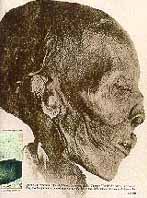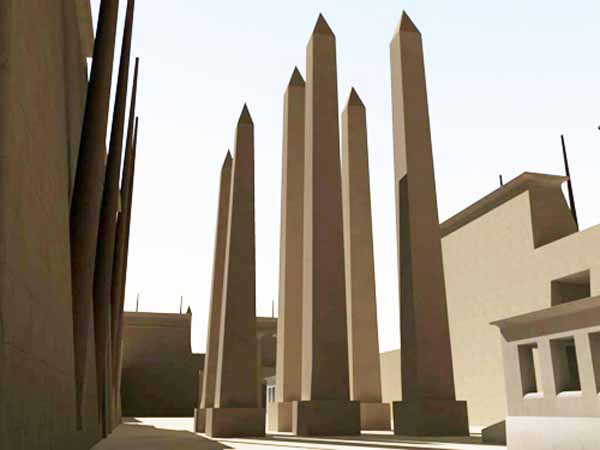BBC - February 19, 2025

The mummified head of Thutmose II (left) and relief of Thutmose II in Karnak Temple complex.
Thutmose II (sometimes read as Thutmosis, or Tuthmosis II and meaning Born of Thoth, probably pronounced during his lifetime as Djhutymose) was the fourth Pharaoh of the Eighteenth dynasty of Egypt. He built some minor monuments and initiated at least two minor campaigns but did little else during his rule and was probably strongly influenced by his wife, Hatshepsut. His reign is generally dated from 1493 to 1479 BC. Thutmose II's body was found in the Deir el-Bahri Cache above the Mortuary Temple of Hatshepsut and can be viewed today in the Egyptian Museum in Cairo.
Thutmose II was the son of Thutmose I and a minor wife, Mutnofret. He was, therefore, a lesser son of Thutmose I and chose to marry his fully royal half-sister, Hatshepsut, in order to secure his kingship. While he successfully put down rebellions in Nubia and the Levant and defeated a group of nomadic Bedouins, these campaigns were specifically carried out by the king's Generals, and not by Thutmose II himself. This is often interpreted as evidence that Thutmose II was still a minor at his accession. Thutmose II fathered Neferure with Hatshepsut, but also managed to father a male heir, the famous Thutmose III, by a lesser wife named Iset before his death.
Some archaeologists believe that Hatshepsut was the real power behind the throne during Thutmose II's rule because of the similar domestic and foreign policies which were later pursued under her reign and because of her claim that she was her father's intended heir. She is depicted in several raised relief scenes from a Karnak gateway dating to Thutmose II's reign both together with her husband and alone. She later had herself crowned Pharaoh several years into the rule of her husband's young successor Thutmose III; this is confirmed by the fact that "the queen's agents actually replaced the boy king's name in a few places with her own cartouches" on the gateway.
Manetho's Epitome refers to Thutmose II as "Chebron" (which is a reference to his prenomen, Aakheperenre) and gives him a reign of 13 years, but this figure is highly disputed among scholars. Some Egyptologists prefer to shorten his reign by a full decade to only 3 years because his highest Year Date is only a Year 1 II Akhet day 8 stela. The reign length of Thutmose II has been controversial and much debated.
Manetho's Epitome has been a debated topic among Egyptologists with little consensus given the small number of surviving documents for his reign, but a 13-year reign is preferred by older scholars while newer scholars prefer a shorter 3-4 year reign for this king due to the minimal amount of scarabs and monuments attested under Thutmose II. It is still possible to estimate when Thutmose II's reign would have begun by means of a heliacal rise of Sothis in Amenhotep I's reign, which would give him a reign from 1493 BC to 1479 BC, although uncertainty about how to interpret the rise also permits a date from 1513 BC to 1499 BC, and uncertainty about how long Thutmose I ruled could also potentially place his reign several years earlier still. Nonetheless, scholars generally assign him a reign from 1493 or 1492 to 1479.
Thutmose's reign is still traditionally given as 13 or 14 years. Although Ineni's autobiography can be interpreted to say that Thutmose reigned only a short time, it also calls Thutmose a "hawk in the nest," indicating that he was perhaps a child when he assumed the throne. Since he lived long enough to father two children - Neferure and Thutmose III - this suggests that he may have had a longer reign of 13 years in order to reach adulthood and start a family.
The German Egyptologist, J. Von Beckerath, uses this line of argument to support the case of a 13-year reign for Thutmose II. Alan Gardiner noted that at one point, a monument had been identified by Georges Daressy in 1900 which was dated to Thutmose's 18th year, although its precise location has not been identified. This inscription is now usually attributed to Hatshepsut, who certainly did have an 18th year.
Von Beckerath observes that a Year 18 date appears in a fragmentary inscription of an Egyptian official and notes that the date likely refers to Hatshepsut's prenomen Maatkare, which had been altered from Aakheperenre Thutmose II, with the reference to the deceased Thutmose II being removed. There is also the curious fact that Hatshepsut celebrated her Sed Jubilee in her Year 16 which von Beckerath believes occurred 30 years after the death of Thutmose I, her father, who was the main source of her claim to power. This would create a gap of 13 to 14 years where Thutmose II's reign would fit in between Hatshepsut and Thutmose I's rule.
Upon Thutmose's coronation, Kush rebelled, as it had the habit of doing upon the transition of Egyptian kingship. The Nubian state had been completely subjugated by Thutmose I, but some rebels from Khenthennofer rose up, and the Egyptian colonists retreated into a fortress built by Thutmose I. On account of his relative youth at the time, Thutmose II dispatched an army into Nubia rather than leading it himself, but he seems to have easily crushed this revolt with the aid of his father's military generals.
Thutmose also seems to have fought against the Shasu Bedouin in the Sinai, in a campaign mentioned by Ahmose Pen-Nekhbet. Although this campaign has been called a minor raid, there is a fragment which was recorded by Kurt Sethe which records a campaign in Upper Retenu, or Syria, which appears to have reached as far as a place called Niy where Thutmose I hunted elephants after returning from crossing the Euphrates. This quite possibly indicates that the raid against the Shasu was only fought en route to Syria.
Thutmose II tomb discovery raises new mysteries: Where is his mummy, and why wasn't he buried in the Valley of the Kings? Live Science - February 26, 2025

The mummified head of Thutmose II (left) and relief of Thutmose II in Karnak Temple complex.
After sifting through tons of limestone in the chamber that they found fragments of alabaster jars, which bore the inscriptions of the names of Thutmose II and his alleged wife Hatshepsut. There they discovered the blue ceiling and decorations of scenes from the Amduat, a religious text which was reserved for kings. This is the last missing tomb of the kings of the Eighteenth Dynasty
The discovery of the pharaoh's tomb caps off more than 12 years of work by the joint team lead by Dr Litherland and Egypt's Ministry of Antiquities. The team has previously excavated 54 tombs in the western part of the Theban mountain in Luxor, and had also established identities of more than 30 royal wives and court women.

Thutmose II's mummy was discovered in the Deir el-Bahri cache, revealed in 1881. He was interred along with other 18th and 19th dynasty leaders including Ahmose I, Amenhotep I, Thutmose I, Thutmose III, Ramesses I, Seti I, Ramesses II, and Ramesses IX.
The mummy was unwrapped by Gaston Maspero on July 1, 1886. There is a strong familial resemblance to the mummy of Thutmose I, his likely father, as the mummy face and shape of the head are very similar. The body of Thutmose II suffered greatly at the hands of ancient tomb robbers, with his left arm broken off at the shoulder-joint, the forearm separated at the elbow joint, and his right arm chopped off below the elbow. His anterior abdominal wall and much of his chest had been hacked at, possibly by an axe. In addition, his right leg had been severed from his body.

A small temple, known as Shespet-ankh (Chapel of Life), was finished by his son, Tuthmosis III. He also had built a pylon shaped limestone gateway in front of the Fourth Pylons forecourt at Karnak which also had to be completed by Tuthmosis III. The material from this gate and another limestone structure were later reused in the building of Karnak's Third Pylon foundation.

However, the gate has since been rebuilt in Karnak's Open Air Museum. Scenes on the gate sometimes depict Tuthmose II with Hatshepsut, and sometimes Hatshepsut alone. On one side of the gate, Tuthmosis II is shown receiving crowns, while other scenes depict his daughter, Nefrure and Hatshepsut receiving life from the gods. We also know of a building project in Nubia at Semna and Kumma, and surviving blocks from his buildings at Elephantine. A statue of Tuthmosis II was found at Elephantine that was probably commissioned by Hatshepsut.